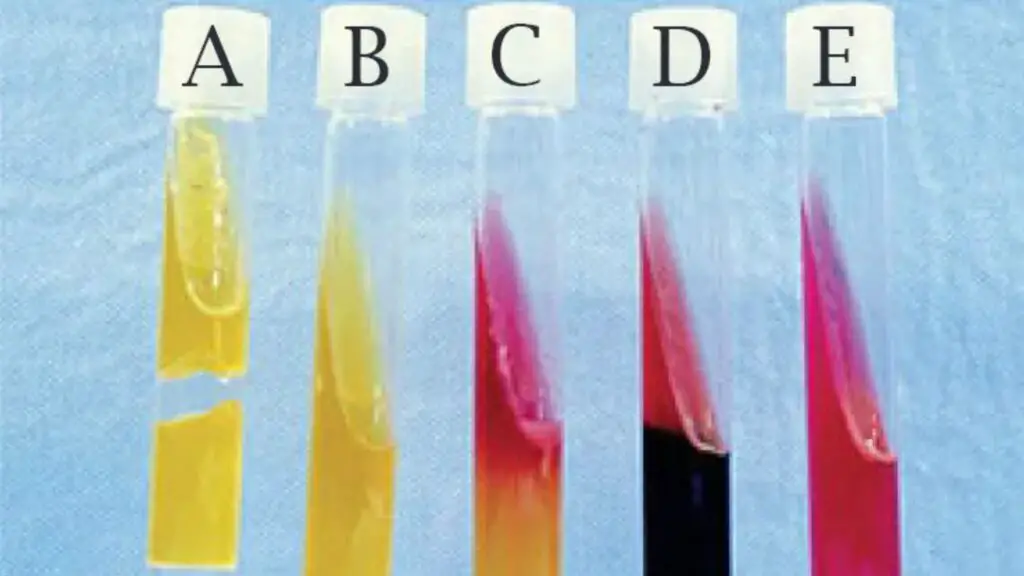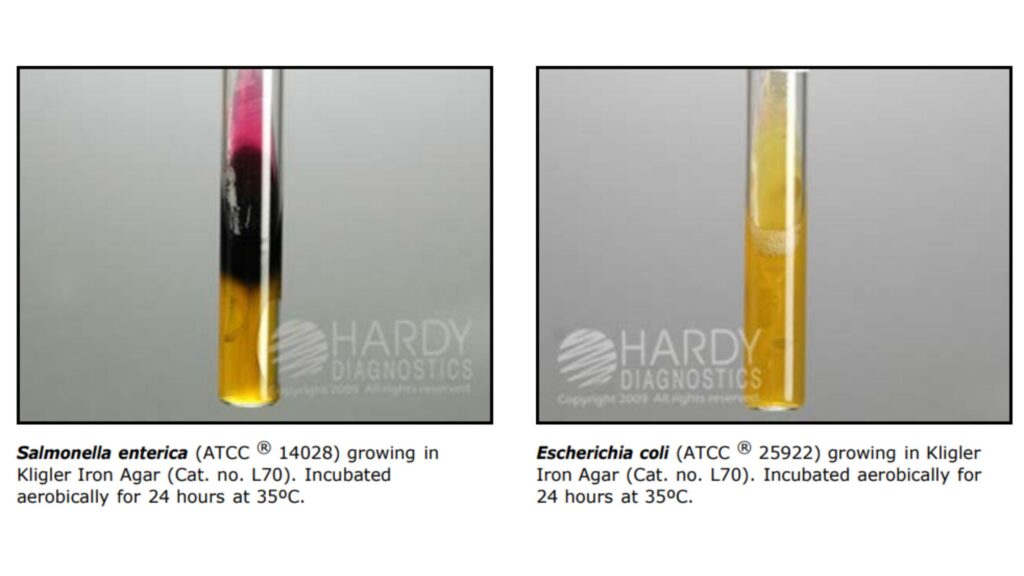Advertisements
Table of Contents
- Kligler Iron Agar is a combination of Kligler’s lead acetate medium and Russels Double Sugar Agar, and it is used to differentiate typhoid, dysentery, and related bacilli.
- Bailey and Lacey replaced the andrade indicator formerly used as pH indicator with phenol red.
- Kligler Iron Agar distinguishes between lactose fermenters and nonfermenters. It separates Salmonella Typhi from other Salmonellae and also Salmonella Paratyphi A from Salmonella Scottmuelleri and Salmonella Enteritidis.
- Fermentation of dextrose produces acid, which changes the colour of the indicator from red to yellow. Since there is little sugar, i.e. dextrose, acid generation is minimal, and a reoxidation of the indicator occurs on the surface of the medium, causing the indicator to remain red.
- However, when lactose is fermented, the huge amount of acid produced prevents reoxidation, resulting in the yellowing of the entire medium.
- In addition to peptone, HM peptone B, and yeast extract, Kligler Iron Agar adds lactose and glucose (dextrose), which facilitates the differentiation of enteric bacilli species.
- The pH indicator is phenol red, which changes colour in reaction to acid created during the fermentation of carbohydrates.
- The combination of ferrous sulphate and sodium thiosulphate permits the detection of hydrogen sulphide generation, which appears as a black hue throughout the butt or in a ring formation near the butt’s apex.
- Lactose non-fermenters (such as Salmonella and Shigella) initially create a yellow slant due to the acid produced by the fermentation of the tiny quantity of glucose (dextrose).
- When the glucose (dextrose) supply is depleted in the slant’s aerobic environment, the reaction reverts to alkaline (red slant) due to the oxidation of acids generated.
- The anaerobic environment of the butt does not undergo reversion, therefore it remains acidic (yellow butt).
- Lactose fermentation results in yellow slants and butts on lactose fermenters.
- The high acid production helps to maintain an acidic pH in an aerobic environment.
- Tubes displaying the natural colour of the medium indicate neither glucose (dextrose) nor lactose fermentation.
- Individual bubbles or the breaking or displacement of the agar due to the creation of fractures in the base of the medium are indicators of gas production (aerogenic reaction).
Purpose of Kligler’s Iron Agar Test
- On the basis of dextrose and lactose fermentation and hydrogen sulphide formation, Kligler Iron Agar is utilised to differentiate microorganisms belonging to the Enterobacteriaceae family.
Principle of Kligler’s Iron Agar Test
- Casein and meat peptones provide the required nitrogenous substances, amino acids, and vitamins for bacterial development.
- Sodium chloride is an electrolyte source that maintains osmotic balance. Lactose and dextrose are carbohydrate sources.
- Phenol red indicates the fermentation of carbohydrates.
- On the slant and in the butt, fermentation reactions are indicated by a change in colour from red (alkaline) to yellow (acidic) (acid).
- The concentration of dextrose in KIA is one-tenth that of lactose.
- This aids to differentiate organisms that ferment just dextrose from those that also ferment lactose.
- The modest quantity of acid created in the slant during dextrose fermentation rapidly oxidises, leading the slant to become alkaline (red).
- Due to the absence of air, the yellow acid reaction continues in the butt.
- Lactose fermenters create yellow slants and butts because fermentation of both sugars produces enough acid in the slant to sustain an acid pH under aerobic circumstances.
- In the absence of glucose fermentation, the slant and butt remain neutral (red).
- The presence of ferric ammonium citrate is indicative of H2S generation.
- If H2S is created from sodium thiosulfate, it interacts with ferric ammonium citrate to make ferrous sulphate (a black precipitate) in the medium.
- The presence of bubbles, a splitting of the medium, or a displacement of the medium indicates gas production.
Composition of Kligler Iron Agar
| Ingredients | Gram/Liter |
| Beef extract | 3 gm |
| Yeast extract | 3 gm |
| Peptone | 15 gm |
| Proteose peptone | 5 gm |
| Lactose | 10 gm |
| Glucose | 1 gm |
| Ferrous sulfate | 0.2 gm |
| Sodium chloride | 5 gm |
| Sodium thiosulfate | 0.3 gm |
| Agar | 12 gm |
| Phenol red | 0.024 gm |
| Distilled water to equal 1 L | |
| Final pH : 7.4 |
Preparation of Kligler Iron Agar
- Suspend 57.52 grammes in 1,000 millilitres of filtered or distillated water.
- To completely dissolve the medium, bring to a boil.
- Mix thoroughly and distribute into tubes.
- Autoclave at 15 pounds of pressure (121 degrees Celsius) for 15 minutes.
- Permit the tubes to cool in a tilted position to create slopes with 1-inch humps.
- The best results are achieved with freshly produced media.
- Do not use tubes or bottles with screw-on caps.
Procedure of Kligler’s Iron Agar Test
- Select an isolated colony from the culture plate using a sterile, straight inoculating needle.
- Remove the tube cover and pierce the medium with a needle.
- Withdraw the inoculating needle from the slope and zigzag up the slope’s surface.
- Replace cap on the tube loosely.
- Observe and record reactions after an overnight (18–24 hour) incubation at 35 2°C under aerobic conditions.
- Without proper growth in the butt and slant, ambivalent emotions will ensue.
Results of Kligler’s Iron Agar Test

Carbohydrate Fermentation
- Positive Test for Slant Reaction – Yellow (acid)
- Negative Test for Slant Reaction – Red (alkaline)
- Positive Test for Butt Reaction – Yellow (acid)
- Negative Test for Butt Reaction – Red (alkaline)
KIA Color Reactions
- Red slant/ yellow butt – dextrose (+), lactose (-)
- Yellow slant/ yellow butt – dextrose (+), lactose (+)
- Red slant/ red butt – dextrose (-), lactose (-)
Hydrogen Sulfide Production
- Positive Test – A black hue across the medium, a black ring at the intersection of the slant and butt, or a black precipitate in the butt.
- Negative Test – No black color development
Gas Production
- Positive Test – The presence of bubbles in the medium, breaking and displacement of the medium, or separation of the medium from the tube’s side and bottom.
- Negative Test – No bubbles and no separation or displacement of the medium

| Name of the Organism | Reactions (Red= Alk, Yellow = Acid) | Gas | H2S |
| Pseudomonas aeruginosa | Alk/Alk | – | – |
| E.coli AD Group | Acid/Acid Alk/Acid | + + | – – |
| Shigella species (S.dysenteriae, S.flexneri, S.boydii, and S. sonnei) | Alk/ Acid | – | – |
| Salmonella Paratyphi A | Alk/ Acid | – | + |
| Salmonella Paratyphi B | Alk/ Acid | + | + |
| Salmonella Paratyphi C | Alk/ Acid | + | + |
| Salmonella Typhi | Alk/ Acid | + | – |
| Other Salmonella serovars | Alk/ Acid | + (weak) | d |
| Klebsiella pneumonia | Acid/Acid | ++ | – |
| Klebsiella oxytoca | Acid/Acid | ++ | – |
| Klebsiella (formerly Enterobacter) aerogenes | Acid/Acid | ++ | – |
| Enterobacter cloacae | Acid/Acid | ++ | – |
| Citrobacter freundii | Acid/Acid or Alk/Acid | + | + |
| Serriatia mercescens | Alk/Acid | + | – |
| Proteus vulgaris | Alk/Acid | +/- | + |
| Proteus mirabilis | Alk/Acid | + | + |
| Morganella morganii | Alk/Acid | + | – |
| Yersinia enterocolitica | Alk/Acid | – | – |
Limitations
- Results should be observed between 18 to 24 hours. Otherwise, it could produce erroneous findings.
- For inoculation, a straight wire loop is required.
- To avoid erroneous results, pure isolates must be utilised.
- Despite the fact that Kligler’s Iron Agar gives useful information for the probable identification of Enterobacteriaceae, a number of additional tests are required for the definitive identification of some species. In addition to biochemical testing, serologic testing must be conducted if Salmonella or Shigella are isolated.
- Organisms that create hydrogen sulphide may generate so much black precipitate that the reaction in the butt is entirely concealed. Even though hydrogen sulphide is not visible, dextrose is fermented if it is created. Hydrogen sulphide measurements on Kligler Iron Agar must be restricted to Enterobacteriaceae.
- A number of mutant species may diverge from the conventional reactions mentioned above, necessitating the use of an extensive variety of carbohydrates and further experiments. When attempting to discover rarer strains, the biological responses must be regarded as a whole.
- It is essential to penetrate the core of the media. Failure to jab the butt renders this test invalid. When stabbed, the agar must keep its integrity. During this test, caps must be unfastened or erroneous findings will occur.
- The formation of hydrogen sulphide by an organism may disguise acid production in the bottom of the medium. Nevertheless, the creation of hydrogen sulphide requires an acidic environment, hence the butt section should be considered acidic if hydrogen sulphide is formed.
- Certain species or strains may exhibit delayed reactions or fail to ferment the carbohydrate in accordance with the instructions. However, if the bacterium fails to ferment dextrose within 48 hours and growth is visible, it is most likely not a member of the family Enterobacteriaceae.
Keynote
- Occasional ambiguous reactions may be caused by the selection of mixed organisms. Whenever there is a doubt, the purity of the culture must be established through repeated testing with an isolate of the organism.
- It is advised to only streak halfway up the slant in order to prevent sugar from reverting to an alkaline reaction (pink/red) at the thin tip of the slant.
References
- Bailey & Scott’s Diagnostic Microbiology, Forbes, 11th edition
- https://himedialabs.com/TD/M078.pdf
- https://microbeonline.com/kliglers-iron-agar-kia-principle-procedure-and-results/
- https://www.nelabservices.com/pdf/tech-sheets/kligler-agar-2016.pdf
- http://biotrading.com/assets/productinformatie/acumedia/tds/7140.pdf
- https://bioactiva.com/pub/media/sebwite/productdownloads//k/l/kligler-iron-agar-kia.pdf
- https://assets.fishersci.com/TFS-Assets/LSG/manuals/IFU61240.pdf
- https://www.clinmicronow.org/doi/abs/10.1128/9781683670438.CMPH.ch3.17-25
- https://www.studocu.com/in/document/rajiv-gandhi-university-of-health-sciences/microbiology/kliglers-iron-agar-test/30880836
- https://www.sigmaaldrich.com/deepweb/assets/sigmaaldrich/product/documents/382/650/60787dat.pdf
- https://www.sigmaaldrich.com/deepweb/assets/sigmaaldrich/product/documents/320/202/k2260dat.pdf
- https://www.neogen.com/categories/microbiology/acumedia-kligler-iron-agar/
- https://www.scharlabmagyarorszag.hu/katalogus/01-103_TDS_EN.pdf
- https://www.biotrend.com/en/buy/cat-kligler-iron-agar-selective-solid-5529.html
- https://labchem-wako.fujifilm.com/jp/category/docs/01976_doc19.pdf
- https://universe84a.com/tsi-test/
